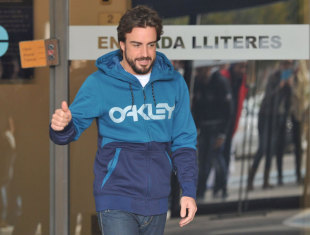
Head injuries are not a trivial matter in sport - especially in one which will never fully eliminate the danger posed to its participants.
Formula One is still reeling from the serious head injuries suffered by Michael Schumacher and Marussia's Jules Bianchi last year, the latter sustained during the Japanese Grand Prix. Alonso's crash in Barcelona was nowhere near as serious as the one Bianchi suffered at Suzuka, but the impact of the Spaniard's head striking the side of his cockpit on impact was enough to knock him unconscious and give him a concussion.
Alonso did not suffer a life-threatening injury in Barcelona but doctors felt the need to keep him in hospital for three nights as a precaution. The memory of Bianchi's crash last year and the fact it was Alonso in Spain may have heightened the level of caution and intrigue - a McLaren spokesperson initially told the media they would not name the hospital because "half of Spain would be outside". But the prevailing reason for the caution afforded to the Spaniard is much easier to understand.
The McLaren statement, which made it clear Alonso is otherwise perfectly healthy, said doctors want to eliminate the risk of a condition known as Second Impact Syndrome (SIS). In the press conference he gave in Barcelona, Ron Dennis frequently mentioned rugby union when talking about Alonso's road to recovery. In January 2011, SIS claimed the life of rugby player Ben Robinson, a 14-year-old from Northern Ireland who collapsed and died after being repeatedly sent back onto the field after being treated for three separate blows to the head.
SIS can occur when a first concussion has not fully healed and another is sustained, leading to the brain swelling rapidly and catastrophically. There is no defined period of how long SIS can be a cause for concern but it is usually held an athlete should not return until the symptoms of the initial injury are completely gone. Crucially, neither impact has to be considered severe for SIS to occur. BrainandSpinalCord.org states: "Second impact injury can result within a matter of days or weeks, or it can occur in the same game or competition if the athlete isn't removed and treated after the first concussion. Neither impact has to be severe for second impact syndrome to occur. Symptoms usually occur immediately following the second impact and progress rapidly."
This new way of thinking about head injury has had a big impact on rugby. Last weekend England's Mike Brown missed the crucial Six Nations fixture against Ireland because he woke up with a mild headache before he had completed the six steps of recovery mandated by World Rugby's 'Return to Play' protocol after suffering a concussion. Doing so sent him back to the first step of recovery and has thus delayed his comeback further. On the surface it may seem like a tiny reason to miss a championship clash but it is all about putting the welfare of the player before an 80-minute game of rugby.
World Rugby's player welfare board sets out the aim of concussion management in simple terms: "Recognise and remove. Recognise the symptoms of concussion and permanently remove a player displaying any of those symptoms." The new stance in rugby ensures authorities err on the side of caution rather than run the risk of players suffering further and more substantial injuries down the line.
And this "risk" point is crucial when dealing with any head injury. Alonso's crash did not lead to serious injury but he was unconscious after his crash and his lengthy stay in hospital reflected that. He is perfectly healthy in every sense of the word but a risk - a minute risk, but a risk all the same - remains and he will miss the first race of the year. It will frustrate his fans, McLaren and the Spaniard himself, but his well-being is and always should be the most important part of this story.
Nate is assistant editor of ESPNF1

